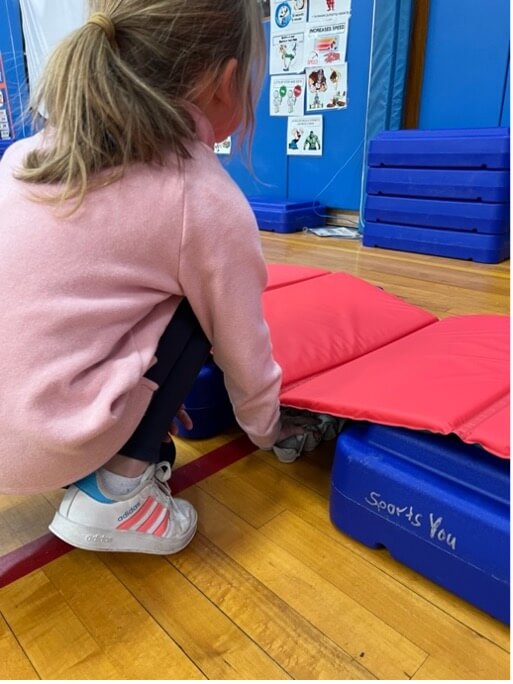Each school year, I teach a unit called “Abilities Awareness”. Making students aware of each other’s different abilities helps us become better citizens and leads to a more positive and inclusive school climate. This awareness leads to empathy and a deeper understanding of our peers’ individual learning needs resulting in a sense of belonging, community, and value in our school community. This unit is also an opportunity to address misconceptions surrounding different disabilities. In the words of Winston Churchill, “Diversity is the one true thing we all have in common. Celebrate it every day.”

Sight Reading Braille
This year, I wanted to introduce my students to the basics of the Braille alphabet. First, my student teacher, Tyler Villez, and I gave the student’s background information on Louis Braille and how he invented a form of written language for people with vision impairments, called Braille. We explained to them that Braille was a written language in which characters are represented by patterns of raised dots felt with the fingers. Our students learned that Braille, as well as enlarged print and audio, was how vision-impaired students accessed instructional materials in school.
We first taught our students how to read the Braille alphabet by sight through a fun Braille scavenger hunt game. The “Fitness Braille Alphabet” posters I used in the game can be found here. https://www.teacherspayteachers.com/Product/Braille-Alphabet-Fitness-9261345. We placed all 26 Braille alphabet posters on cones and scattered them around the gym.

We then gave students index cards with words, written in Braille. The students had to race around the gym trying to identify each Braille letter in the word, by referencing the Braille Alphabet Fitness posters. Once they found a matching letter, they would do the exercise on the poster that corresponded to that letter. For example, if they figured out that the first letter of their word was an L then they would have to do 5 lunges before moving on. When they found all the letters to the word and did all the exercises, they had to race to me and tell me the word the letters spelled (each word was a name of a vegetable). If they were correct, they would get another word. Partners with the most completed words “won” the game but the real victory was the students experiencing a different way to read using Braille. Students learned that having a visual impairment did not mean they could not read, they just did it in a different way. Just like the word ‘disability’ does not mean inability. My intention for this activity was not to teach the entire braille code but rather to raise awareness at an introductory level.
Writing in Braille
Another game we played focused on introducing the students to write in Braille. The students used this blank alphabet template, with the above Braille Alphabet Fitness cards, and raced around the room trying to locate and fill in each cell in the alphabet. Once they found the next letter in the alphabet, they had to perform the exercise on the poster before moving on to the next letter. This was a great assessment tool and the students got to take it home with them.

Many students reported to me that they used their completed Braille alphabet key to write letters to their friends. They loved using it because their siblings and parents couldn’t read the letters since they were not familiar with the Braille alphabet!
Reading Braille by Feel
My favorite game was when my student teacher and I cut egg cartons in half and used them as blank cells to create letters in Braille.


We used ping pong balls as the embossed Braille dots. One partner would race down to the right side of the gym and create a letter in Braille using the egg carton and ping pong balls. They can choose any letter they wish. Their partner would be doing the same thing on the opposite side of the gym. Once they both finished creating their letter with ping pong balls, they must both cover the egg carton with a yoga mat so their partner can’t see it. They would then race and switch sides with each other, slide their hands under the yoga mat, and by feeling the ping pong balls, decide what letter it was. (Leave a key next to the egg carton for the students to use as a reference). When they think they have figured out which letter it is, they both have to meet in the middle of the gym. Each partner will take turns guessing their letter. If they are correct, they get to do 3 sit-ups to celebrate. If they are incorrect, give your partner a high-five and tell them “Nice try!” Then their partner will guess. When they are finished, they can play again.


We also played site word relay races. Teams of two would be given a 4-5 letter word. The goal was for the students to create each letter of the word in Braille using egg cartons and ping pong balls. On ‘go’, they must scooter down to the other side of the gym and create the first letter of the word, then scooter back. Next, their partner would scooter down and make the 2nd letter in the word and scooter back. They would continue this pattern until they completed the entire word. Once each team finished their word, they had to do team synchronized sit-ups until all other teams finished creating their word. Teams get one point per synchronized sit-up they perform in each round.

My students really enjoyed learning about Braille and playing games that exposed them to it. By raising the student’s awareness of different abilities we are giving students opportunities to learn from one another. They develop understanding, acceptance, and empathy and are helping to create a positive and inclusive school environment for all.


Here is a great resource to help teach Braille to students. https://hadley.edu/workshops/learn-basic-braille-by-sight-reading-series/braille-reading-by-sight-letters-aj
